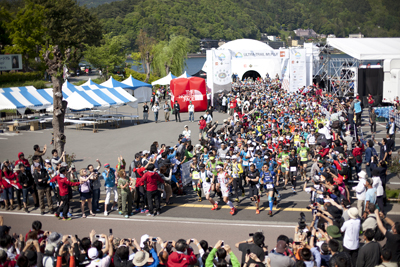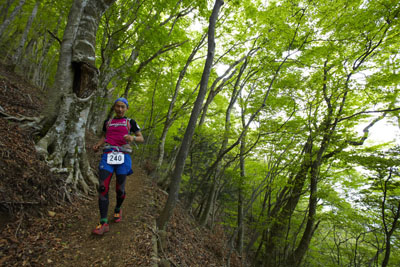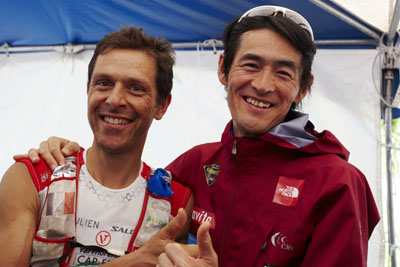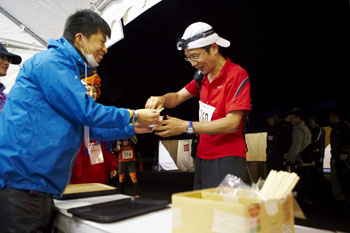|
Ultra-Trail Mt. Fuji:
The ultimate challenge comes to Japan
BY ANDREW LEE
Staff writer
How far can you run?
Five kilometers?
Ten?
How about 160?
Impossible, right?
Then how about doing it in just two days?
If that doesn't sound like absolute madness, you may be interested in the Ultra-Trail Mt. Fuji (UTMF), a trail-running race that circles Japan's most famous mountain, held for the first time last month.

Natural high: The journey begins May 18. Runners are greeted by majestic views of Mount Fuji and the
surrounding forests as they follow the course of the Ultra-Trail Mt. Fuji race. KOICHI MIYAGAMI, KAZU NAGAYASU PHOTOS

Modeled after the Ultra-Trail du Mont-Blanc (UTMB), the UTMF is Japan's first 100-mile (160-km) race and is the first sister race to the UTMB, which has been held in Europe since 2003. Traversing France, Italy and Switzerland, the UTMB course passes through the Alps, over glaciers, valleys and 400 summits as it makes its way around Mont Blanc, Europe's highest mountain. It has been called "the race of all the superlatives" and is one of the toughest races in the world.
Trail runner and UTMF race director Tsuyoshi Kaburaki, who has completed the UTMB four times, said that the race "deeply changed" his life.
"It was during this race that I was tested to my utmost limits, both physically and mentally," he said. "I was forced to dig very, very deep within me to give it everything I had."
Ever since the first time Kaburaki crossed the UTMB finish line in Chamonix, France, he wanted to create a similar race in his home country that would capture the same epic spirit as the original — and what better place than Mount Fuji, a mountain famous for its beauty and severity.
As Japan's highest mountain, Mount Fuji holds a special place in the hearts of the Japanese people. Along with sakura (cherry blossoms) and geisha, the mountain is one of the most iconic images of Japan. Over the centuries, artists and pilgrims alike have been attracted by the sacred mountain's beauty and mystical aura. It's said that all Japanese should climb Mount Fuji at least once in their life to see the sunrise from its peak.
Yet, while as many as 200,000 people each year make the long climb to the 3,776-meter summit to take in the amazing view, nowhere near as many have experienced the natural wonders of the landscape below.
The organizers of the UTMF hope to remedy this and have charted a course that connects mountain trails, local footpaths, and forest roads that circumnavigate the still-active volcano, creating what is being called the toughest trail race in the world.
Created over thousands of years by numerous volcanic eruptions, Mount Fuji spreads out in a near-perfect cone running 38 km from east to west and 44 km from north to south. In 864, a large eruption caused an enormous flow of lava down the northwestern side of the mountain. In time, a forest grew on top of the lava field and the undulating shapes of the volcanic rocks were covered in green moss. Covering an area of 3,000 hectares, this ancient forest, through which the UTMF course passes, became known as the Aokigahara Jukai, or the Sea of Trees.
Other areas the course passes through include the beech forests of Mikuniyama, the volcanic gravel fields near Subashiri and the Suyama and Murayama trails located in the southern foothills. During the Nara Period (710-794), these historic trails were used by the Shugendo mountain monks as part of their ritual pilgrimages up Mount Fuji.

First-place runner Julien Chorier of France is congratulated by UTMF organizer
Tsuyoshi Kaburaki at the finish line on May 19. KAZU NAGAYASU PHOTO
Because of the rich diversity and history of the area the UTMF Race Committee worked closely with the many regional authorities in Shizuoka and Yamanashi prefectures, nature conservation groups and local people in the Mount Fuji area to ensure that the environmental impact of the race would be minimal. The trails and fire roads along most of the course have long-been used and enjoyed by hikers, and initially there was strong opposition by some toward the race.
To convince local authorities to hold the race, Kaburaki had to first explain exactly what trail running was. Some of those opposed to the race asked why the race could not simply be run on roads. Eventually, Kaburaki was able to communicate that trail running connects people with nature, and that the wonders of the Mount Fuji area would benefit from more exposure.
The UTMF won the support of the people, who have been extremely supportive of the concept and provided much-needed advice on how to adequately protect the many important flora and fauna in the area. This advice has been incorporated into the race's environmental and safety guidelines in an effort to ensure that the race will be able to be held again in the future.
Originally, the UTMF was scheduled to take place in May 2011, but was postponed due to March 11 Great East Japan Earthquake and tsunami, and the ongoing nuclear crisis. In place of the postponed race, a two-day cleanup event was held along the course, organized by the Fuji Trail Runners Club from May 21 to 22, 2011. A second cleanup event was held on Dec. 11, 2011. Another cleanup was also held after this year's race.
With an extra year of preparation and cleaning completed, on May 18, 2012, the inaugural Ultra-Trail Mount Fuji, and Asia's first 100-mile trail race, was finally able to get under way.
Prior to the race, Canadian Adam Campbell, one of the participants in this year's UTMF, summed up the attraction of trail running when he said at a pre-race event: "Trail running engages all the senses: You get to feel the trail, smell the trail, you get to see the sights. It's very special to be out there (in nature)."
Race facts and figures
 Support: Volunteers along the course help participants. KAZU NAGAYASU PHOTO
Number of runners: 852
Male: 777 (562 completed within the time limit, 72.3 percent)
Female: 75 (49 completed within the time, 65.3 percent)
Average age (before start):
Male: 41.8
Female: 40.7
Oldest runner (after start):
66, male
Youngest runner (after start):
18, female
According to its organizers, the purpose of the UTMF is "to communicate the importance of challenging the human spirit through the outdoor sport of trail running, and to provide the opportunity for people to enjoy and discover the natural beauty and culture of the Mount Fuji region."
Japanese culture has historically had a very close connection to the natural environment, but the UTMF race organizers believe that this has changed in recent times and that people have started to lose sight of this important connection. By holding the UTMF around Japan's most sacred mountain the hope is that participants will realize the importance of human coexistence with nature and respect toward the natural environment.
So, on the afternoon of May 18, 852 runners, including some of the best trail runners in the world, took up the challenge and began the race around Mount Fuji.
Starting at Ohike-koen (837 meters above sea level) the course then climbs to 1,400 meters before heading down to Fujiyoshida (715 meters). It then heads to Niju-magari (1,240 meters) hitting 1,600 meters along the way. Next is Yamanaka-ko (983 meters), then, at just past the 50-km mark, Subashiri (830 meters). The trail then climbs to Fujisan-tarobo (1,422 meters) and Mizu-ka-tsuka (1,466 meters) before hitting Kodomo-no-kuni (970 meters), which is also the starting point for the shorter, 82-km Shizuoka to Yamanashi (STY) race that is also a part of the event. It then descends to Kitayama (603 meters) and, at just past the 100-km mark, reaches its lowest point at Nishi-Fuji (519 meters). From there the course enters its most challenging section as it passes through many steep up-and-down sections, climbing rapidly to its highest point (1,950 meters) at around 120 km, before a steep 6-km descent to Motosu-ko (906 meters). The trail then passes through Narusawa-hyoketsu (1,025 meters) before ending at Ohike-koen.
The total distance is 156 km and the change in altitude equals more than 8,000 meters. The time limit given the race was 48 hours — though the pros need much less time.
The first to complete the course was Julien Chorier from France, in the staggering time of 18 hours, 53 minutes, 12 seconds. After crossing the finish line, Chorier, who looked like he still had plenty of energy, said that the highlight of the race was seeing the sunrise over Mount Fuji. "I have never seen a red sun like that," he said. "It turned Fuji red."
When asked what he felt about the course itself, he stated that the UTMF was a "much harder race than the UTMB." In particular, the 30-km stretch after the 100-km mark was the hardest race trail he had ever run. Chorier also praised the organizers of the event and the many volunteers who manned the checkpoints along the way.
"The trail markers were perfect," he said. "It's the first time I have run a 100-mile race and not got lost."
Next to cross the finish line was Campbell, who was running his first 100-mile race, in a time of 19:26:29.
"Julien is better in the downhills than me," Campbell explained. "I fell maybe eight times. I think there will be a lot of people dirtier than me, and quite a few bloody knees, cuts and bruises."
Third past the line was the first Japanese runner, Kenichi Yamamoto in a time of 21:15:02 (see interview below).
In the end, 611 of the original 852 starters were able to complete the course, and as Campbell predicted, many of them had been battered and bruised by the grueling race. But that is just part of the experience of joining that elite group of trail runners who have completed the hardest trail race in the world. It is hoped that the UTMF will be held again in 2013 and that more people will be tempted to test their endurance among the uniquely beautiful trails around Mount Fuji.
For more information, visit the official website, www.ultratrailmtfuji.com.
Finish-line interview with third-place runner Kenichi Yamamoto of Japan
How was the course?
It was really hard. There are various trails, some of which need a lot of skill to run. So I think it's very hard to complete the full distance.
What do you think of your time and the place you finished?
I never care about that. I just kept running at my own pace the whole way and I was able to finish. So I am entirely satisfied that I did my best.
What was it like running an entire 100-mile race?
It was fun! At night, I could see thousands of stars in the sky. And in the morning, Mount Fuji was incredibly beautiful. It looked much bigger than usual.
Compare the UTMF to the UTMB.
In a word, the UTMF is squishy and the UTMB is firm. There are many sections of the trail covered with fallen leaves around Mount Fuji and some courses are quite muddy. But Mont Blanc is mostly rocky hills. Since I'm a local person (from Yamanashi Prefecture), I always practice around Mount Fuji, so I think it was a great advantage for me as well as for other Japanese people (because most mountains in Japan have a similar terrain to Mount Fuji). However, there are also many concrete road courses, and the last 5 km was especially hard. So, as I said, it is a very difficult course. But I could enjoy that last section with a good view of Lake Kawaguchi.
Did you have a strategy, because you seemed to keep a slow pace during the first half?
Not really, but I planned to increase my pace from Nishi-Fuji junior high school (just past the 100-km mark). I didn't really mean to run slowly at first, but I kept the pace naturally. And the last half was the same, too. After I passed the junior high school though, my pace automatically increased.
Any comments for race director Tsuyoshi Kaburaki?
Congratulations! At least three people completed the course (at the time). (Laughs.)
Would you like to do it again?
Sure! I really hope this event will be held next year, too!
|


